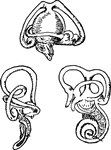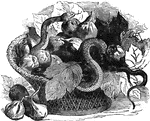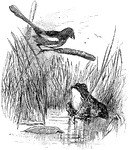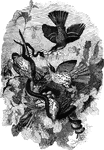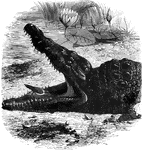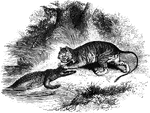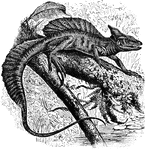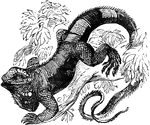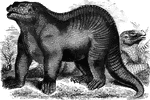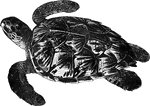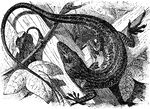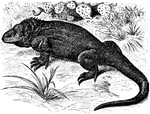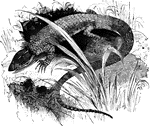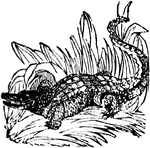
Alligator
This animal can swallow small prey whole. the female alligator takes more care of her young than the…

Alligator
The Mississippi alligator grows to a length of fourteen or fifteen feet, inhabiting lakes, rivers, and…
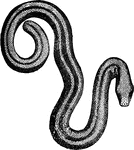
Brown amphisbaena
Ranging from eighteen to twenty-four inches long, the brown amphisbaena feeds on worms and insects,…

Bishop's Staff - Head with Serpent Design
Illustration of the head of a bishop's staff, also called a crosier. The head is a serpent curled around…
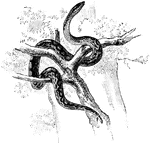
Ringed Boa
The Ringed Boa (Epicrates cenchria) is a non-venomous snake in the Boidae family of boas.

American box-tortoise
Posessing a nearly perfectly hemispherical shell, the American box turtle ranges from Canada to Florida.…

Blanding's box-tortoise
Ranging throughout the Northern and Middle States, Blanding's box-tortoise measures seven to inches…
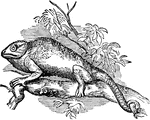
Chameleon
"A genus of saurian reptiles, constituting a distinct family, of very peculiar form and structure, and…

Common Chameleon
The common chameleon (Chamaeleo chamaeleon) is a lizard that is well known for its camouflage ability.

Head of Chameleon
"Chameleon is a genus of reptiles belonging to the Saurian or lizard-like order, a native of parts of…

Chirotherium Tracks
An illustration of a fossil containing Chirotherium tracks. Chirotherium (also known as Cheirotherium)…

Circulation of a Reptile
Diagram of the circulation of the reptile. Labels: a, pulmonic, and b, somatic circulation; c, heart…

Cobra Head
Cobras are venomous snakes of the familys Elapidae, of several genera, but particularly Naja. (Non-cobra…
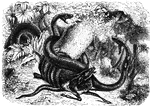
Boa constrictor
"The boa constrictor grows to great size, and greatly resembles the python in its habits." — Goodrich,…
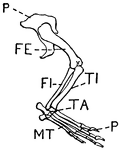
Leg of Crocodile
This illustration shows the leg of a crocodile. P. Pelvis, FE. Femur, TI. Tibia, FI. Fibula, TA. Tarsus,…
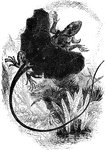
Flying dragon
The flying dragon gets its name from its ability to glide for short distance using a thin membrane.
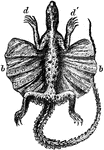
Red-Throated Dragon
"The Red-Throated Dragon shows a large membranous expansion (b b) situated between the anterior (d d)…
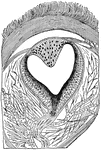
Eye of a Lizard
Longitudinal section through the pineal eye of a lizard. The eye is located in the middle of the dorsal…
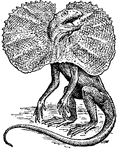
Frilled Lizard
Found in Oueensland and other parts of Australia, this lizard belongs to the family Agamidae. It reaches…
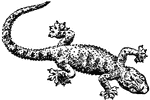
Gecko
A gecko is a small, four-footed member of the lizard family Geckonidae. Geckos are widely distributed…
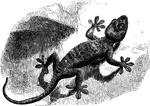
Wall gecko
Found throughout Southern Europe, the wall gecko averages about six inches in length. It draws its name…

Glass-snake
Found in the woods of the Southern States, the glass-snake has the head of a lizard, but the body resembles…
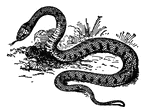
Grass Snake
Its color is olive-gray or brown above, with black bands and spots, and checkered black and white beneath.…
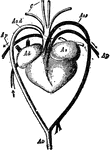
Heart and Blood Vessels of a Turtle
Heart and blood vessels of the turtle. Ad, right auricle; As, left auricle; Ao.d, right arch of the…
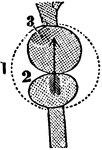
A Diagram of the Heart of a Reptile
A diagram of the heart of a reptile. Labels: 1, Pericardium. 2, Single ventricle. 3, Left auricle. 4,…
Archaeopteryx Skeleton
An illustration of an Ichthyosaurus skeleton. Ichthyosaurus is an extinct genus of ichthyosaur from…

Ichthyosaurus Skull
An illustration of an Ichthyosaurus skull. Ichthyosaurus is an extinct genus of ichthyosaur from the…

Common iguana
A large lizard, the common iguana is common to the tropical regions of the Americas. It spends much…
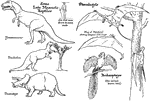
Late Mesozoic Age Reptiles
Some Late Mesozoic reptiles. Shown are the Tyrannosaurus, Trachodon, Triceratops, Pterodactyls, and…
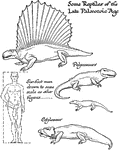
Reptiles of the late Paleozoic age
Some reptiles of the Late Paleozoic Age. The six-foot man is drawn to the same scale as the other animals.

Lizard
Lizards are scaly reptiles, having two pairs of limbs and an elongated body, with a long, tapering tail,…

Lizard
Lizards are good climbers and fast runners, and usually live in trees. Some can change their skin color…
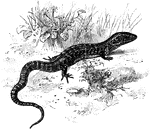
Northern Alligator Lizard
The Northern Alligator Lizard (Elgaria coerulea) is a lizard in the Anguidae family that was also known…
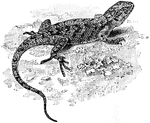
Eastern Fence Lizard
The Eastern fence lizard (Sceloporus undulatus) is a medium sized species of lizard common along the…
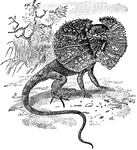
Frill-Necked Lizard
The Frill-Necked Lizard (Chlamydosaurus kingii) is a lizard in the Agamidae family. "C. kingi has a…
